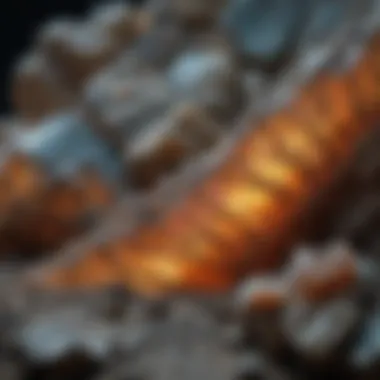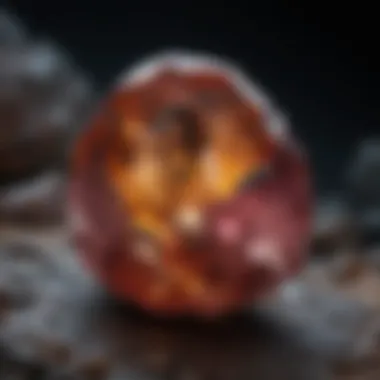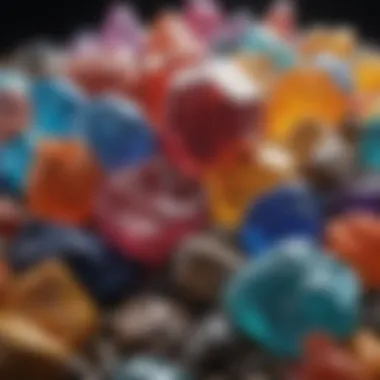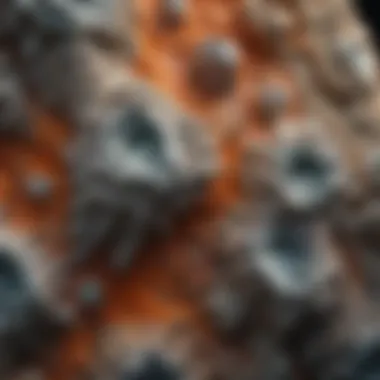Unveiling the Magnificence of Rare Museum-Quality Mineral Specimens


Rock and Fossil Identification
In the realm of museum-quality mineral specimens, the identification of rocks and fossils plays a pivotal role in understanding their unique characteristics and origins. Meticulous observation is essential in discerning the types of rocks and fossils present, looking for distinct features that differentiate one specimen from another. Various tools, such as magnifying lenses, hardness picks, and UV lights, aid in the identification process, enabling collectors to unravel the intricate details preserved within these geological treasures.
Collecting Tips and Techniques
For aspiring collectors venturing into the realm of mineral specimens, adopting best practices is crucial for a fulfilling and fruitful experience. Understanding where to locate prime collecting sites is paramount, guiding enthusiasts to regions abundant in diverse geological formations. When extracting specimens, employing safe techniques is imperative to prevent damage to the delicate structures of rocks and fossils, ensuring their integrity for preservation and display.
Preservation and Display
Preserving the beauty and integrity of museum-quality mineral specimens requires employing meticulous techniques to maintain their pristine condition over time. Implementing proper storage methods, such as utilizing climate-controlled cabinets and archival-quality containers, mitigates potential damage from environmental factors. In terms of display, exploring creative ideas enhances the aesthetic appeal of the specimens, showcasing them in a visually striking manner that highlights their exquisite forms and intricate details.
Geological Insights
Delving into the geological insights offered by museum-quality mineral specimens provides a fascinating glimpse into the Earth's history and evolution. Exploring the unique formations and processes that give rise to rocks and fossils enhances our understanding of the planet's geological diversity. Uncovering the historical significance of specific specimens and notable discoveries in the field of mineralogy sheds light on the intricate interplay between the Earth's elements, offering a profound appreciation for these geological marvels.
Intro to Museum Quality Mineral Specimens
For enthusiasts and collectors alike, the realm of museum quality mineral specimens serves as a captivating journey into the extraordinary. This segment lays the foundational understanding of what sets these specimens apart from the ordinary. Highlighting their rarity, exquisite beauty, and geological origins, we embark on an exploration of treasures that transcend simple aesthetic appeal. From the intricate details of crystal formations to the fascinating geological processes that give birth to these specimens, this section sets the stage for a deeper dive into the marvelous world of museum-quality minerals.
Defining Museum Quality
When it comes to classifying minerals as museum quality, certain criteria stand out as defining factors. These criteria play a pivotal role in elevating select specimens to a level that demands admiration and study. By examining the unique features that qualify a mineral for this prestigious title, we gain insight into the characteristics that make them coveted pieces for collectors and researchers alike. Exploring the criteria for classifying minerals as museum quality unveils not just their aesthetic value but also their scientific significance, making them highly sought after in the world of mineralogy.
The criteria for classifying minerals as museum quality
Central to the discussion of museum-quality minerals is the key criterion used to distinguish them from commonplace specimens. This criterion acts as a lens through which we can understand the exceptional nature of these minerals, shedding light on their rarity and beauty. By delving into the specifics of what makes a mineral worthy of a place in a museum collection, we unravel the intricacies that captivate the minds of enthusiasts and scholars alike. The detailed examination of this criterion offers a nuanced perspective on the allure and importance of museum-quality minerals, enriching our appreciation for these geological wonders.
Significance of Museum Quality Specimens


Museum-quality mineral specimens not only captivate the eyes but also contribute significantly to the realms of scientific research and education. Their impact is two-fold, balancing between aesthetic appeal and substantial educational value. By diving into the significance of these specimens, we uncover the profound influence they exert on various facets of human knowledge and understanding.
Impact on scientific research and education
The role of museum-quality specimens in scientific research and education is immeasurable. These exquisite examples of nature's artistry provide scientists and educators with invaluable resources for study and exploration. Through their detailed examination, researchers gain crucial insights into geological processes and mineral compositions, expanding the frontiers of knowledge in the field. Furthermore, these specimens serve as educational tools, engaging students and enthusiasts in the wonders of geology and mineralogy, fostering a deep appreciation for the intricate beauty of the natural world.
Cultural and historical importance
Apart from their scientific significance, museum-quality specimens also carry a profound cultural and historical importance. These minerals hold within them a narrative of the earth's history, reflecting the geological transformations that have shaped our planet over millennia. By examining these specimens through a cultural and historical lens, we not only appreciate their aesthetic splendor but also connect with the ancient forces that have crafted these mesmerizing formations. Their cultural and historical value adds layers of meaning to these minerals, making them not just scientific artifacts but also resonant symbols of our planet's ever-evolving story.
Characteristics of Museum Quality Mineral Specimens
Museum quality mineral specimens hold a profound significance in the realm of geology and mineralogy. These specimens are not merely rocks; they are exceptional examples of the Earth's geological wonders. The characteristics that define museum quality specimens go far beyond their aesthetic appeal. They serve as invaluable tools for scientific research, enabling experts to study the unique mineral formations, their crystal structures, and the environments in which they were created. Collectors and enthusiasts are drawn not only to the beauty of these specimens but also to their rarity and the story they tell about our planet's intricate geologic history. Understanding the characteristics of museum quality mineral specimens is key to appreciating their true worth and value.
Crystal Clarity and Form
In the world of museum quality mineral specimens, crystal clarity and form play a pivotal role. The unique crystal structures found in these specimens offer a window into the intricate processes that shaped them over millennia. The crystal clarity dictates the transparency and purity of the mineral, showcasing its internal perfection and complexity. Collectors and researchers alike are captivated by the distinct forms these crystals take, from geometric precision to free-form masterpieces. Crystal clarity and form provide vital clues about the conditions under which the minerals formed, shedding light on the geological events that occurred deep within the Earth's crust.
Unique crystal structures
Unique crystal structures represent the signature of each mineral specimen, like a fingerprint in the vast mosaic of nature. These structures encapsulate the precise arrangement of atoms and molecules that give rise to the crystal's visible shape and properties. The key characteristic of unique crystal structures lies in their diversity and complexity, showcasing the remarkable variability in nature's mineral creations. Their intricate patterns and symmetries contribute to the allure of museum quality specimens, making them highly sought after for both scientific study and aesthetic appreciation. While some structures may create challenges in identification or classification, their uniqueness adds a layer of intrigue and fascination to the world of mineral collecting.
Color and Luster
The allure of museum quality mineral specimens is often heightened by their vibrant hues and mesmerizing luster. The color of a mineral stems from impurities or trace elements present during its formation, resulting in a stunning array of tones and shades. Luster, on the other hand, describes the way light interacts with the mineral's surface, ranging from dazzling shine to subtle glow. Both color and luster contribute significantly to a specimen's visual appeal, drawing in collectors with their captivating beauty and enhancing the overall aesthetic value.
Vibrant hues and reflective surfaces
Vibrant hues and reflective surfaces create a visual feast for enthusiasts of museum quality mineral specimens, evoking a sense of wonder and admiration. The key characteristic of vibrant hues lies in their ability to convey the mineral's chemical composition and history through a stunning array of colors. Reflective surfaces enhance the play of light on the specimen, unveiling hidden iridescence and sheen that add depth to its allure. While vibrant colors can make identification easier, they can also be influenced by factors such as light exposure and environment, requiring careful preservation to maintain their integrity. Despite potential challenges, the captivating beauty of colorful minerals remains a cornerstone of mineralogy appreciation.
Rarity and Uniqueness


One of the most defining features of museum quality mineral specimens is their rarity and uniqueness. These specimens are not commonly found in nature, making each discovery a cause for celebration among collectors and researchers. The uncommon mineral compositions present in museum quality specimens offer insights into Earth's geological diversity and the extraordinary processes that govern mineral formation. Their rarity elevates their value, turning them into coveted treasures that hold both scientific and aesthetic significance.
Uncommon mineral compositions
Uncommon mineral compositions stand at the heart of museum quality specimens, setting them apart from run-of-the-mill rocks. These compositions are often the result of specific geological conditions and rare elemental interactions that produce minerals not easily found elsewhere. The key characteristic of uncommon mineral compositions lies in their ability to challenge existing knowledge and expand our understanding of mineralogy. Their unique features offer a glimpse into the Earth's diverse mineralogical palette, showcasing the breadth of nature's creativity and complexity. While their rarity may pose challenges in sourcing and acquisition, the allure of possessing such exceptional specimens drives collectors to explore far and wide in search of these geological marvels.
Formation and Geological Processes
Exploring the intricate world of museum-quality mineral specimens necessitates a profound understanding of the formation and geological processes that shape these marvels. The significance of this topic within the realm of mineralogy is paramount, laying the foundation for comprehending the unique attributes and defining characteristics exhibited by these specimens. By delving into the formation and geological processes, we unravel the mysteries of how time, pressure, and natural factors collaborate to produce these rare geological treasures that captivate collectors and scientists alike.
Natural Factors
Heat, pressure, and time
Unpacking the intricate interplay of heat, pressure, and time in the genesis of museum-quality mineral specimens unveils a tapestry of geological processes that have sculpted Earth's wonders over eons. The enduring allure of this trio lies in their transformative capacity, molding ordinary minerals into extraordinary crystalline manifestations. Heat refines elements, pressure bestows structure, and time imbues a patina of ageless beauty upon these specimens. The exceptional resilience of minerals subjected to this triumvirate renders them enduring testaments to geological time scales, offering insights into Earth's evolution.
Environment and Conditions
Impact of geologic settings
In the exploration of museum-quality mineral specimens, the variable impacts of geologic settings emerge as pivotal determinants of mineral formation. These settings, be they deep-sea vents or mountainous terrains, harbor unique conditions that orchestrate the emergence of distinct mineralogical compositions. The character and composition of minerals are intricately entwined with the geological context within which they originate. Understanding the nuances of geologic settings enriches our appreciation of these specimens, shedding light on the geological narratives encapsulated within their crystalline structures.
Popular Museum-Quality Minerals
Popular Museum-Quality Minerals play a pivotal role in the realm of mineral specimens, offering enthusiasts and collectors a diverse array of specimens to explore and appreciate. In this article, we delve into the significance of these minerals and their appeal to the discerning audience of rock and fossil collectors. By examining the characteristics, rarity, and allure of popular museum-quality minerals, we shed light on their unique contribution to the world of mineralogy, providing a comprehensive guide for enthusiasts and collectors alike.
Fluorite
When discussing Fluorite, we are drawn into a realm of mesmerizing hues and stunning locations that exemplify its unique beauty and geological importance. The varieties and locations of Fluorite exhibit a spectrum of colors and formations, each reflecting the intricate geological processes that gave birth to these exquisite specimens. Exploring the nuances of Fluorite's varieties and locations allows us to grasp the essence of this mineral's diversity and its significance in both scientific research and collector circles.


Quartz
Quartz stands as a cornerstone in the world of mineral specimens, known for its diverse forms and inherent properties that captivate collectors and researchers alike. From its varied crystal structures to its wide range of uses, Quartz embodies a blend of aesthetic appeal and scientific value, making it a focal point in our exploration of museum-quality minerals. Analyzing the diverse forms and properties of Quartz unveils its versatility and enduring allure, solidifying its place as a beloved choice for collectors and enthusiasts seeking both beauty and substance.
Tourmaline
Tourmaline, renowned for its vivid color range and multifaceted uses, represents a gemstone of choice for discerning collectors and aficionados. The color range and uses of Tourmaline showcase its versatility and desirability across different cultural contexts and scientific disciplines. Unraveling the unique features of Tourmaline's color range and applications provides a deeper understanding of its appeal and importance in the realm of museum-quality mineral specimens, offering enthusiasts a glimpse into the captivating world of this remarkable gemstone.
Collecting and Preserving Museum Quality Specimens
In the realm of museum-quality mineral specimens, Collecting and Preserving take center stage as crucial components in safeguarding these geological marvels. The meticulous act of procuring these specimens involves a delicate balance of ethical considerations and practical conservation efforts. Preservation ensures that these treasures remain intact for future generations, maintaining their scientific and aesthetic value. From sourcing ethically to upholding conservation standards, collectors play a pivotal role in ensuring the longevity and accessibility of these exceptional specimens.
Ethical Sourcing
Responsible practices
Delving deeper into the world of Responsible practices in Ethical Sourcing, we unravel the intricate web of principles guiding collectors in their pursuit of museum-quality mineral specimens. Responsible practices encompass a spectrum of approaches aimed at sustainable acquisition and respect for environmental and cultural considerations. Key to these practices is the emphasis on transparency, traceability, and fair trade in dealing with mineral sources. By adhering to Responsible practices, collectors uphold ethical standards, mitigate environmental impact, and support local communities involved in mineral extraction. This conscientious approach not only enhances the credibility of collectors but also contributes to the overall conservation and appreciation of these geological wonders.
Display and Conservation
Proper storage and care
Turning our focus towards the realm of Display and Conservation, the spotlight shines on the critical importance of Proper storage and care in maintaining the integrity of museum-quality mineral specimens. Proper storage involves utilizing suitable containers, controlled environments, and protective measures to prevent damage or degradation of specimens. Careful handling and periodic assessment ensure that these treasures retain their original beauty and scientific value. Conserving these specimens not only honors their intrinsic worth but also safeguards them from external factors that could compromise their integrity. Balancing aesthetics with practicality, collectors partake in a timeless endeavor of protecting these geological masterpieces for generations to come.
The End
In the realm of museum-quality mineral specimens, the subject of Conclusion serves as a critical juncture that encapsulates the essence of our exploration. It stands as a pivotal reflection on the intrinsic value and allure of these geological treasures. The Conclusion section not only ties together the thematic threads woven throughout the article but also underscores the enduring significance of understanding and appreciating the beauty and rarity of these specimens. By delving into their unique characteristics, historical importance, and scientific relevance, the Conclusion imparts a sense of closure while simultaneously igniting a desire for further discovery and contemplation.
Appreciating the Beauty and Rarity
The enduring allure of museum-quality mineral specimens
The enduring allure of museum-quality mineral specimens lies in their exceptional beauty that transcends the boundaries of time and culture. These specimens possess a timeless quality that captivates collectors and enthusiasts alike, showcasing nature's artistry in its purest form. Their rarity adds a layer of mystique, making them coveted pieces for those who yearn to possess a slice of geological history. The enduring allure of these specimens serves as a testament to the Earth's remarkable ability to craft intricate and breathtaking masterpieces over millennia. As a focal point in our discourse, the enduring allure of museum-quality mineral specimens amplifies the article's central message - that these treasures are not mere objects but windows into a world of wonder and awe.
Continued Exploration and Discovery
The ongoing fascination with Earth's geological wonders propels individuals towards a ceaseless quest for knowledge and understanding. It underscores humanity's enduring curiosity and reverence for the natural world. Within this context, the exploration of museum-quality mineral specimens becomes a symbiotic journey of learning and appreciation. The relentless pursuit of uncovering new discoveries and unraveling geological mysteries resonates deeply with those enamored by Earth's rich tapestry. By delving into the depths of mineral formations and geological processes, enthusiasts pave the way for continuous exploration and discovery, fueling a passion that transcends generations. The ongoing fascination with Earth's geological wonders not only enriches our understanding of the past but also shapes the trajectory of future scientific endeavors, underscoring the intrinsic value of preserving and studying these precious relics of our planet.







